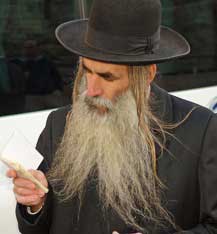Additionally, most Chassidic men wear a gartel when they pray. It is a thin black belt with fringe (white ones are used on special occasions, like a wedding, when a man wears a special white garment). In halacha (Shulchan Aruch O.C. 91:1), a physical divider between a man's heart and genitalia is required during prayer. The rebbes insist that a regular belt will not suffice and there must be something that specifically divides the body into the lower parts and the upper parts, exerting control of the animal instincts with human intellect.

Lastly, Orthodox men wear tzitzit, white threads that often hang out of men's clothing. Sometimes there is one blue thread in each one. This comes from Bamidbar (Numbers) 15:38 -- "Speak to the children of Israel, and bid them that they make them fringes on the borders of their garments throughout their generations." To fulfill this, men wear a tallit katan, an undergarment that has fringes on the four corners. Chassidic boys receive them on their third birthday. Some groups wear them under the shirt, while other groups wear it over an undershirt but under the main shirt. (Side story: my father was giving a talk to a group of Christians one day and this woman came up to him afterward with scissors. She was about to cut the "string" he had hanging off his pants until he stopped her!)
Hair and Head Covering

Head covering is not just for women. While men put fringes on the four corners of their garments, they also leave the four corners of their hair to grow. Vayikrah (Leviticus) 19:27 -- "You shall not round off the peya (taken to mean hair) of your head." That is why many Chassidic men don't shave their beards and leave the long payis. Not all groups require the payis grow long but shaving the head is discouraged. There are many different types of this tradition. Though the curly payies are most well known, many other styles can be found. Some groups leave them long and straight, some don't grow them further than the bottom of the ear, some wrap them behind their ears, and some even take them and tuck them under their kippah.
The kippah is an essential part of men's dress. Married or not, men over the age of three must always cover their head. Most often, a kippah or yarmulke is sufficient. However, some Chassids encourage a double covering during prayer just to be sure the head is covered, so they will always wear a hat over their kippah. While most don't shower or sleep with one, some sects encourage men to wear them while they sleep. There are many types of kippot. See Kippah Types, because the type usually indicates what movement of Judaism the wearer follows.
Tznuit does not just refer to dress, but also to behavior. This extends to singing, touching, and privacy. The female voice is considered beautiful. In the Song of Solomon (2:14) it says, "Let me hear your voice, for your voice is sweet ("arev") and your face is beautiful." The Talmud calls this ervah (nakedness). As a general rule, in Ultra-Orthodox communities, women do not sing in front of men.
With regard to touching, negiah, Orthodox men and women who are not related or married do not generally touch. Men will not shake a woman's hand, rabbis don't hug their female congregants, and a distant relative won't hug a distant female relative. This can apply even to a spouse in a public setting. Since husbands and wives don't touch during the time a woman is niddah (on her period), couples won't ever touch in public so as not to alert others as to her cycle, since that is private and not for others to know. To adhere to these rules is to be shomer negiah.
The last item is called yichud or private situations. Men and women who aren't married don't allow themselves to be alone together, simply to avoid temptation. When Orthodox couples date, they are never secluded, preferring public places like hotel lobbies and parks for dates
Personally, I ran the gamut up to the Chabad minhag and back. It was very hard to tell a business associate that you couldn't shake his hand. There were days that I just wanted to throw on a pair of old jeans and t-shirt. It would have been very easy to stay in my old ways, but the journey I took into modesty, tzniut, was an enlightening one. I appreciated myself for who I was, I realized my worth beyond my face and body, and I saw the beauty in covering up. Today, my choice is to wear pants about half the time and I know that when I marry, covering my hair will be important, as will following the laws of niddah (family purity), but I found my balance and the beauty in the action of modesty.
Talia Davis is the daughter, granddaughter, and great-grandaughter of rabbis. She directs the Jewish Portal at Patheos and manages the site's online community.





